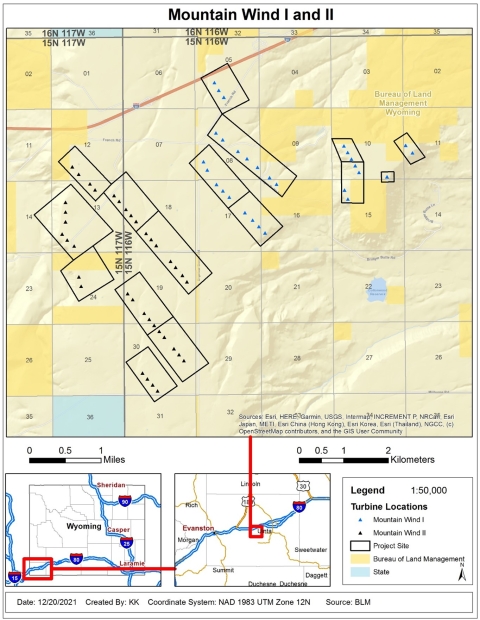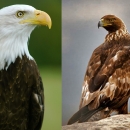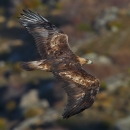Project Description
Mountain Wind Power, LLC and Mountain Wind Power II, LLC (Applicants) are the developers and operators of the existing Mountain Wind I Wind Energy Project (MW-I) and Mountain Wind II Wind Energy Project (MW-II; collectively Projects) located in Uinta County, Wyoming. MW-I consists of 29 wind turbine generators (WTGs) and MW-II consists of 38 WTGs. The Projects have been operational since 2008 and have an expected life of at least 30 years. The Applicants submitted two Incidental Eagle Take Permit (IETP) applications and Eagle Conservation Plans (ECPs) to the U.S. Fish and Wildlife Service (Service) requesting the maximum 30-year permit under the 2016 Eagle Act regulations.
Potential Eagle Impacts
Since 2012, a combination of monitoring and incidental observations has documented 21 golden eagle fatalities (twelve at MW-I and nine at MW-II). Take, including killing of eagles, is prohibited by the 2016 Bald and Golden Eagle Protection Act (Eagle Act). However, the Service has been delegated the authority to issue IETPs, where the take is determined to be compatible with the preservation of eagles. The Service will issue permits for such take only after an applicant has committed to undertake all practical measures to avoid and minimize such take and mitigate anticipated take to the maximum extent achievable. The Applicants have been working with the Service since 2012 to reduce impacts on eagles through avoidance and minimization measures.
The Applicants have developed and provided an ECP that summarizes project design, construction and operational measures taken to avoid and minimize impacts to eagles, and results of post-construction monitoring efforts.
The Service has completed an Environmental Assessment (EA) for the potential issuance of the permits under the 2016 Eagle Act regulations. The EA assesses the potential effects of issuing two IETPs and a No Action alternative (i.e., do not issue a permit) on the human and natural environment. The Service’s Collision Risk Model (CRM) predicts that up to 0.01 bald eagles and up to 0.6 golden eagles at MW-I and up to 0.01 bald eagles and 2.81 golden eagles at MW-II could be killed incidentally on an annual basis as a result of the operation of the Projects. The Service did not have sufficient pre-construction eagle-use data to update exposure for the CRM related to the Project to estimate annual fatalities; therefore, we used the national priors for the eagle exposure parameter. We then used Evidence of Absence (Dalthorp et al. 2017) to analyze the post-construction mortality monitoring data collected on the Project sites from 2017–2018 and used the resulting expected value of fatalities to iteratively update the collision probability prior.
Project Review
The Service has an independent statutory responsibility under the National Environmental Policy Act (NEPA) to evaluate its own actions related to the Projects, namely the possible issuance of two IETPs. A draft EA evaluating the impact of issuing (and not issuing) IETPs for the existing Projects was made available for a 30-day comment period. It has been determined that there is no new significant information, and the Service has prepared a Finding of No Significant Impact (FONSI) in accordance with NEPA regulations (40 C.F.R § 1508.13). Two IETPs will be issued under the 2016 Eagle Act regulations and will authorize non-purposeful take of bald eagles and golden eagles.
News and Updates
The U.S. Fish and Wildlife Service (Service) is releasing the final EA, Finding of No Significant Impact (FONSI), and findings document for the issuance of two IETPs for the operation of the Project. The 30-year permits authorize the potential take of bald and golden eagles associated with the operation of the Projects and outlines required conservation and compensatory mitigation measures for minimizing and offsetting potential eagle take, pursuant to the 2016 regulations of the Eagle Act.
Documents
Relevant documents, linked below, include the final Environmental Assessment, the Finding of No Significant Impact, the Eagle Conservation Plans (ECPs), and the Intra-service Section-7 Biological Evaluation Form.








